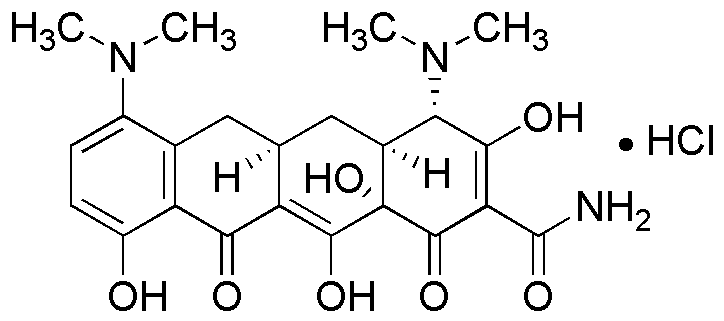Minocycline hydrochloride is widely utilized in research focused on
- Antibiotic Treatments: It is primarily used to treat various bacterial infections, including acne and respiratory tract infections, making it a valuable option in dermatology and general medicine.
- Anti-inflammatory Applications: Beyond its antibacterial properties, it has shown effectiveness in reducing inflammation, which is beneficial in treating conditions like rheumatoid arthritis.
- Neuroprotective Research: Studies indicate potential neuroprotective effects, suggesting applications in neurodegenerative diseases such as Alzheimer's, providing hope for innovative treatment strategies.
- Veterinary Medicine: Minocycline hydrochloride is also used in veterinary practices for treating infections in animals, highlighting its versatility across species.
- Research on Antibiotic Resistance: It serves as a critical compound in studies aimed at understanding and combating antibiotic resistance, which is a growing concern in healthcare.
General Information
Properties
Safety and Regulations
Applications
Minocycline hydrochloride is widely utilized in research focused on
- Antibiotic Treatments: It is primarily used to treat various bacterial infections, including acne and respiratory tract infections, making it a valuable option in dermatology and general medicine.
- Anti-inflammatory Applications: Beyond its antibacterial properties, it has shown effectiveness in reducing inflammation, which is beneficial in treating conditions like rheumatoid arthritis.
- Neuroprotective Research: Studies indicate potential neuroprotective effects, suggesting applications in neurodegenerative diseases such as Alzheimer's, providing hope for innovative treatment strategies.
- Veterinary Medicine: Minocycline hydrochloride is also used in veterinary practices for treating infections in animals, highlighting its versatility across species.
- Research on Antibiotic Resistance: It serves as a critical compound in studies aimed at understanding and combating antibiotic resistance, which is a growing concern in healthcare.
Documents
Safety Data Sheets (SDS)
The SDS provides comprehensive safety information on handling, storage, and disposal of the product.
Product Specification (PS)
The PS provides a comprehensive breakdown of the product’s properties, including chemical composition, physical state, purity, and storage requirements. It also details acceptable quality ranges and the product's intended applications.
Certificates of Analysis (COA)
Search for Certificates of Analysis (COA) by entering the products Lot Number. Lot and Batch Numbers can be found on a product’s label following the words ‘Lot’ or ‘Batch’.
*Catalog Number
*Lot Number
Certificates Of Origin (COO)
This COO confirms the country where the product was manufactured, and also details the materials and components used in it and whether it is derived from natural, synthetic, or other specific sources. This certificate may be required for customs, trade, and regulatory compliance.
*Catalog Number
*Lot Number
Safety Data Sheets (SDS)
The SDS provides comprehensive safety information on handling, storage, and disposal of the product.
DownloadProduct Specification (PS)
The PS provides a comprehensive breakdown of the product’s properties, including chemical composition, physical state, purity, and storage requirements. It also details acceptable quality ranges and the product's intended applications.
DownloadCertificates of Analysis (COA)
Search for Certificates of Analysis (COA) by entering the products Lot Number. Lot and Batch Numbers can be found on a product’s label following the words ‘Lot’ or ‘Batch’.
*Catalog Number
*Lot Number
Certificates Of Origin (COO)
This COO confirms the country where the product was manufactured, and also details the materials and components used in it and whether it is derived from natural, synthetic, or other specific sources. This certificate may be required for customs, trade, and regulatory compliance.


